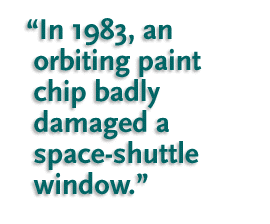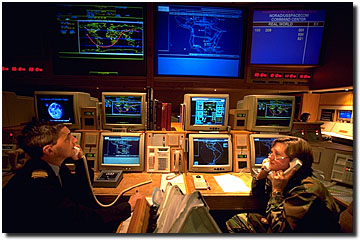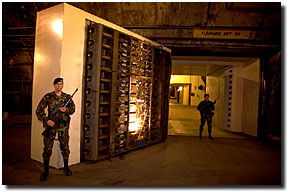 uman garbage is as ancient as cave paintings; if it weren't for garbage, half of all archeologists would be unemployed. Since the dawn of the space age, trash has been accumulating rapidly in the last frontier -- and with it, the danger of a collision with expensive satellites or, worse, manned spacecraft, including the shuttle.
uman garbage is as ancient as cave paintings; if it weren't for garbage, half of all archeologists would be unemployed. Since the dawn of the space age, trash has been accumulating rapidly in the last frontier -- and with it, the danger of a collision with expensive satellites or, worse, manned spacecraft, including the shuttle. That's why the U.S. Space Command (SPACECOM) was created in 1985. Its mission: to track the 9,000 rocket parts and other debris circling the earth at 17,000 miles per hour. "At those speeds, you don't need much mass to inflict damage," says Major Robin Alford, a military spokesman. In 1983, an orbiting paint chip badly damaged a space-shuttle window. SPACECOM uses the most advanced cybertechnology -- radar, telescopes, and high-resolution videocameras -- to scan for space junk. The data collected are transmitted to Cheyenne Mountain, Colorado, where an underground fortress is protected by a 25-ton, H-bomb-resistant front door. This is also the home of NORAD, the North American Aerospace Defense Command. These are the folks who have been using advanced communications networks for years to watch for incoming missiles. Little did they know, in the heyday of the Cold War, that their multibillion-dollar systems would one day be used to follow floating garbage.
|

 uman garbage is as ancient as cave paintings; if it weren't for garbage, half of all archeologists would be unemployed. Since the dawn of the space age, trash has been accumulating rapidly in the last frontier -- and with it, the danger of a collision with expensive satellites or, worse, manned spacecraft, including the shuttle.
uman garbage is as ancient as cave paintings; if it weren't for garbage, half of all archeologists would be unemployed. Since the dawn of the space age, trash has been accumulating rapidly in the last frontier -- and with it, the danger of a collision with expensive satellites or, worse, manned spacecraft, including the shuttle. 







